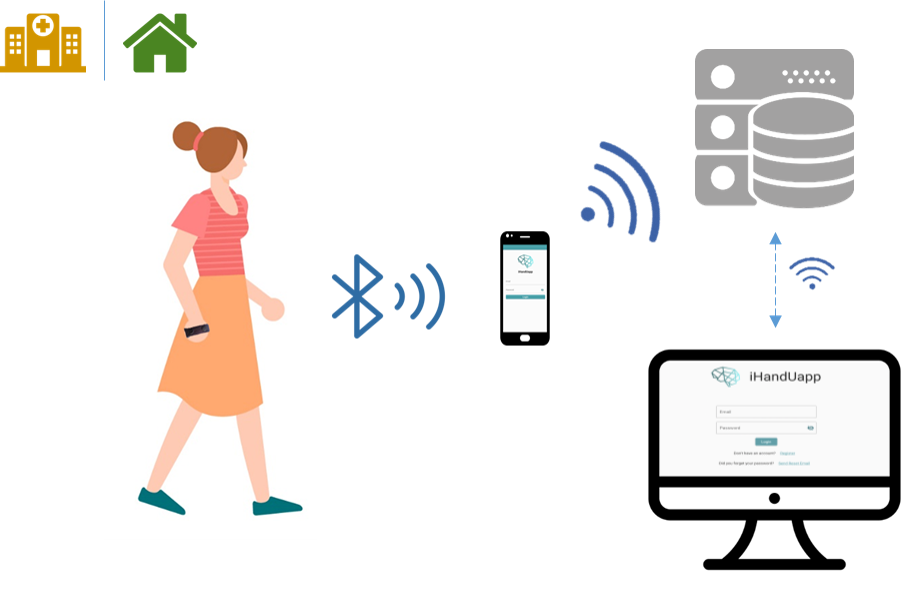Category: Parkinson's Disease: Neurophysiology
Objective: This clinical study aims to evaluate the feasibility of a novel wearable system to quantify and monitor Parkinson’s disease (PD) motor symptoms (MS). In this abstract we present bradykinesia preliminary results.
Background: PD is a complex and difficult to manage disease, due to high symptom variability and medication efficiency, limited appointment frequency, and lack of measurable information monitoring. Additionally, existing symptom rating scales are subjective and rely on doctors’ perception [1-4].
INESC TEC and Centro Hospitalar Universitário de São João (CHUSJ) are developing a real-time system to quantify PD MS, enabling remote monitoring of patients and support of medical assessments using a wearable appcessory, its companion mobile application, and a web medical dashboard. The data flow is shown in Fig. 1 [figure1].
Method: The system quantifies rigidity, bradykinesia, tremor and gait impairment using MDS-UPDRS III scoring. During routine clinical appointments, with minor alterations to the typical procedures, we acquired inertial data from 32 patients, with an average age of 67.3±3.9 years and an even sex distribution, while physicians evaluate symptom severity. The study was approved by CHUSJ Ethics Committee.
We developed features extraction algorithms from data collected during each exercise to automatically estimate symptom severity. An A-NOVA and Kruskal Wallis statistical analysis to all the features during bradykinesia evaluation exercises was used to analyze its automated MS severity discrimination capacity.
Results: Bradykinesia was evaluated with the hand open-close exercise in 29 individuals: MDS-UPDRS=0 (n=5), 1 (n=3), 2 (n=16), 3 (n=5), 4 (n=0). A set of 12 features were extracted from the inertial signals. We found that 4 of these features (mean angle, mean amplitude, mean duration and total power) showed statistically significant discrimination (p<0.05) across scores, thus automatically estimating the MS severity.
Conclusion: This preliminary analysis shows the presented system’s potentiality to estimate MS severity. Furthermore, it provides results in near-real-time, making it highly usable in PD clinical practice and for home monitoring. More patients will be enrolled in the study and other MS will be incorporated in the system to contribute for a more objective approach in the clinical management of PD.
References: [1] Cabreira, V., & Massano, J. (2019). Parkinson’s disease: Clinical review and update. Acta Medica Portuguesa, 32(10), 661–670. https://doi.org/10.20344/amp.11978
[2] Armstrong, M. J., & Okun, M. S. (2020). Diagnosis and Treatment of Parkinson Disease: A Review. JAMA, 323(6), 548–560. https://doi.org/10.1001/JAMA.2019.22360
[3] Heijmans, M., Habets, J. G. V., Herff, C., Aarts, J., Stevens, A., Kuijf, M. L., & Kubben, P. L. (2019). Monitoring Parkinson’s disease symptoms during daily life: a feasibility study. NPJ Parkinson’s Disease, 5(1). https://doi.org/10.1038/S41531-019-0093-5
[4] Monje, M. H. G., Foffani, G., Obeso, J., & Sánchez-Ferro, A. (2019). New Sensor and Wearable Technologies to Aid in the Diagnosis and Treatment Monitoring of Parkinson’s Disease. Annual Review of Biomedical Engineering, 21, 111–143. https://doi.org/10.1146/ANNUREV-BIOENG-062117-121036
To cite this abstract in AMA style:
A. Arrais, D. Dias, J. Silva Cunha, J. Massano, C. Soares. Clinical practice feasibility of a wearable appcessory for quantitative evaluation of motor symptoms in Parkinson’s disease [abstract]. Mov Disord. 2023; 38 (suppl 1). https://www.mdsabstracts.org/abstract/clinical-practice-feasibility-of-a-wearable-appcessory-for-quantitative-evaluation-of-motor-symptoms-in-parkinsons-disease/. Accessed April 1, 2025.« Back to 2023 International Congress
MDS Abstracts - https://www.mdsabstracts.org/abstract/clinical-practice-feasibility-of-a-wearable-appcessory-for-quantitative-evaluation-of-motor-symptoms-in-parkinsons-disease/

